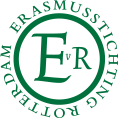Dichter
Phoebe Power

Phoebe Power
(Verenigd Koninkrijk, 1993)
Biografie
Phoebe Power’s poetry has a kaleidoscopic quality. Her work combines image, character and narrative with a variety of forms to create strange and compelling pieces that can be both charming and elusive. Her unique admixture of humour and horror, the erotic and the political, has garnered attention and critical acclaim. Her first full length collection was a Poetry Book Society Recommendation and was shortlisted for the TS Eliot Award. Shrines of Upper Austria received the Felix Dennis Forward Prize for Best First Collection in 2018 with the judges calling Power an “utterly contemporary voice”.
A pamphlet, Harp Duet, appeared from Eyewear Publishing in 2016. As the title suggests there is a musical theme to the 13 poems, but they are multi-sensory objects:
a harp picture, one harp
and two harpists, two halves
of a heart. Conceiving and expanding
wings, great arms embracing
art or children, or pilgrims
or mothers, a boy and a girl
holding space by strings
but never touching
each other
‘Harp Duet’
Here we can see Power, as she often does, inserting gaps – making spaces which are physical and temporal, breaths and blinks. The relationship between sound and silence is one of the many types of duet which shape and animate this pamphlet. Just as the noise is made by both the string and the air around it, it is the gaps which allow Power’s words and images to reach us. It’s an idea which she strums upon in the final poem too, entwining the idea of harp strings and heartstrings:
Fingerbone tightened
to break, your palms
rubbed to their stringed-up gut, nails
softened and brown, now
you are like a saint, body bled
to its wire in hammering
labour, muscle held between metal,
inside the carved DNA of birds
and twigs – the corelines – the heart.
‘Corelines’
This poem is “after Mallarmé” which indicates another pairing that occurs, that of the author with other writers and artists – ‘Munch’s Madonna’ makes this explicit, but elsewhere the visual imagery Power conjures is reminiscent of religious idols or the lusciousness of Gustav Klimt’s tangled, gilded images. With these “dialogues” Power is able to balance an impressive number of concerns and references in a handful of subtle, delicate poems. In 2017 the pamphlet was performed live, alongside sounds from a piano which was wrecked in the floods of winter 2015: “With the wooden side of the upright piano removed, recordings were made of the metal strings inside”, the forces of nature becoming yet another collaborator.
Although none of the poems in Harp Duet feature in Shrines of Upper Austria, we can see the same approach in Power’s first collection, which was published by Carcanet in 2018. In the Poetry Book Society Spring Bulletin, Power wrote that she was aiming for “a decentring of the authorial voice, inviting the possibility of dialogue or a duet”. She cites the sequence ‘Austrian Murder Case’ as the germ of the collection:
'[…] that was the start of an extended exploration of the culture and environment of Austria, where I was living at the time. I became absorbed in the process of juxtaposing different kinds of related fragments – image, story and voice – which is how the project grew into a body of interconnected pieces.' (Interview with the Forward Arts Foundation)
Storytelling is central to Power’s work. Alongside the narrative sequence of ‘Austrian Murder Case’ (which takes a slant angle, skipping between perspective and even telling the story from a lake’s point of view), sit a number of poems about Power’s Austrian grandmother who moved to the UK after the Second World War. ‘Es war einmal’ tells the fairytale-like story of a foundling child in a fairytale-like way; simple, detached, and skipping across years and between events with a kind of fatalism:
One night, he stuck his dick in her. The other man came, and he wanted to take her to England and marry her, and Christl had nowhere else to bring the child, and she would not leave it by the river, so she crossed the sea.
There are also poems in Christl/Chris’s own voice. As Mary Jean Chan has written, “By juxtaposing her perspective with that of her grandmother’s, [Power] creates a polyphony of voices and memories” review here. In ‘silver white winters that melt into springs’ the two perspectives illustrate the reality of climate change, with Christl’s youthful experience of snow-covered Austria compared with the present experience:
it’s warm in December and can snow in april, rain may flood through all the weeks in may and when it’s hot, it’s achingly white hot heat and when it snows, it spits wet pellets then melts on dark grey roads and there are
no more
clear winter days or autumn sunshine
just sticky long grass flying in a wet wind
From ecological disasters to eating disorders, Shrines of Upper Austria wanders widely in themes. Beside the sequences we have single pieces, each enigmatic in its isolation, and what it leaves unsaid. The said (and unsaid) is at the heart of this book which gathers together a great variety of voices. In The Poetry Review (108:2 Summer 2018), Declan Ryan stated that there is “a great deal of action taking place in [the collection’s] use of voice, in its hair-trigger reflexes. Power has a real knack for speech, not only in the poems in the reported, often ungrammatical and characterful English of an Austrian grandmother, but in less obviously vocalised lyrics, too.”
German is embedded beside English in the text, unglossed until the end of the book. But in ‘Epiphany Night’ the language which is truly foreign, and deserves the indication of italics, is the bell’s “tungatungatungatung”. There is a political dimension to the insistence on bilingualism, in refusing to shed either language or identity. Many of the poems in the book speak with the voices of the displaced, of those living in different countries and tongues than they were born in; this is a collection that is concerned with our changing world and the global and individual consequences.
Power personally conceives of the collection “as a shrine: a gathering of objects, words and images important to someone, both as discrete objects and as a composition” (Poetry Book Society Spring Bulletin, 2018). These poems conjure a physical presence from their qualities as words on the page, sounds in the air, sense and sensory evocations – they are full of texture and touch. But while the idea of a “shrine” is one which may seem to look back, to commemorate, Power’s is a poetry that looks at the present and the future too, which insists we must look both ways, and hear all these stories in dialogue.
© Emily Hasler
Harp Duet, Eyewear Publishing, London, 2016Shrines of Upper Austria, Carcanet, Manchester, 2018
LINKS
Poet’s website
How I did it: ‘Rina’: Phoebe Power for the Poetry School
Collaborative multi-media project Christl
Live performance of Harp Duet
Ideos of Phoebe Power reading at the Forward Prizes for Poetry
Gedichten
Gedichten van Phoebe Power
Sponsors
























